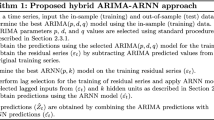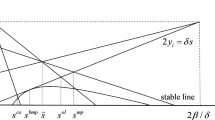Abstract
We develop a data-driven methodology based on parametric Itô’s Stochastic Differential Equations (SDEs) to capture the real asymmetric dynamics of forecast errors, including the uncertainty of the forecast at time zero. Our SDE framework features time-derivative tracking of the forecast, time-varying mean-reversion parameter, and an improved state-dependent diffusion term. Proofs of the existence, strong uniqueness, and boundedness of the SDE solutions are shown by imposing conditions on the time-varying mean-reversion parameter. We develop the structure of the drift term based on sound mathematical theory. A truncation procedure regularizes the prediction function to ensure that the trajectories do not reach the boundaries almost surely in a finite time. Inference based on approximate likelihood, constructed through the moment-matching technique both in the original forecast error space and in the Lamperti space, is performed through numerical optimization procedures. We propose a fixed-point likelihood optimization approach in the Lamperti space. Another novel contribution is the characterization of the uncertainty of the forecast at time zero, which turns out to be crucial in practice. We extend the model specification by considering the length of the unknown time interval preceding the first time a forecast is provided through an additional parameter in the density of the initial transition. All the procedures are agnostic of the forecasting technology, and they enable comparisons between different forecast providers. We apply our SDE framework to model historical Uruguayan normalized wind power production and forecast data between April and December 2019. Sharp empirical confidence bands of wind power production forecast error are obtained for the best-selected model.











Similar content being viewed by others
References
Aït-Sahalia, Y.: Maximum likelihood estimation of discretely sampled diffusions: a closed-form approximation approach. Econometrica 70(1), 223–262 (2002). https://doi.org/10.1111/1468-0262.00274
Alfonsi, A.: Affine Diffusions and Related Processes: Simulation, Theory and Applications, Bocconi and Springer Series, vol. 6. Springer, Berlin (2015). https://doi.org/10.1007/978-3-319-05221-2
Badosa, J., Gobet, E., Grangereau, M., Kim, D.: Day-ahead probabilistic forecast of solar irradiance: a stochastic differential equation approach. In: Drobinski, P., Mougeot, M., Picard, D., Plougonven, R., Tankov, P. (eds.) Renewable Energy: Forecasting and Risk Management, pp. 73–93. Springer, Cham (2018). https://doi.org/10.1007/978-3-319-99052-1_4
Deng, Y., Barros, A., Grall, A.: Degradation modeling based on a time-dependent Ornstein-Uhlenbeck process and residual useful lifetime estimation. IEEE Trans. Reliab. 65(1), 126–140 (2016). https://doi.org/10.1109/TR.2015.2462353
D’Onofrio, G., Tamborrino, M., Lansky, P.: The Jacobi diffusion process as a neuronal model. Chaos 28, 103119 (2018). https://doi.org/10.1063/1.5051494
Egorov, A.V., Li, H., Xu, Y.: Maximum likelihood estimation of time-inhomogeneous diffusions. J. Econom. 114, 107–139 (2003). https://doi.org/10.1016/S0304-4076(02)00221-X
Elkantassi, S., Kalligiannaki, E., Tempone, R.: Inference and sensitivity in stochastic wind power forecast models. In: Papadrakakis, M., Papadopoulos, V., Stefanou, G. (eds.) 2nd ECCOMAS Thematic Conference on Uncertainty Quantification in Computational Sciences and Engineering, Eccomas Proceedia UNCECOMP 2017, pp. 381–393 (2017). https://doi.org/10.7712/120217.5377.16899
Forman, J.L., Sorensen, M.: The Pearson diffusions: a class of statistically tractable diffusion processes. Scand. J. Stat. 35(3), 438–465 (2008). https://doi.org/10.1111/j.1467-9469.2007.00592.x
Iacus, S.M.: Simulation and Inference for Stochastic Differential Equations: With R Examples. Springer Series in Statistics. Springer, New York (2008). https://doi.org/10.1007/978-0-387-75839-8
IRENA: Uruguay Power System Flexibility assessment: IRENA FlexTool Case Study. Abu Dhabi (2018)
IRENA: Innovation Landscape for a Renewable-Powered Future: Solutions to Integrate Variable Renewables. Abu Dhabi (2019)
Iversen, E.B., Morales, J.M., Møller, J.K., Madsen, H.: Probabilistic forecasts of solar irradiance using stochastic differential equations. Environmetrics 25(3), 152–164 (2014). https://doi.org/10.1002/10.1002/env.2267
Iversen, E.B., Morales, J.M., Møller, J.K., Madsen, H.: Short-term probabilistic forecasting of wind speed using stochastic differential equations. Int. J. Forecast. 32(3), 981–990 (2016). https://doi.org/10.1016/j.ijforecast.2015.03.001
Karatzas, I., Shreve, S.E.: Brownian Motion and Stochastic Calculus, Graduate Texts in Mathematics, vol. 113, 2nd edn. Springer, New York (1998). https://doi.org/10.1007/978-1-4612-0949-2
Lamperti, J.: A simple construction of certain diffusion processes. J. Math. Kyoto Univ. 4(1), 161–170 (1964). https://doi.org/10.1215/kjm/1250524711
Leonenko, G., Phillips, T.: High-order approximation of Pearson diffusions processes. J. Comput. Appl. Math. 236, 2853–2868 (2012). https://doi.org/10.1016/j.cam.2012.01.022
Møller, J.K., Madsen, H.: From State Dependent Diffusion to Constant Diffusion in Stochastic Differential Equations by the Lamperti Transform. Tech. Rep. IMM-Technical Report-2010-16, Technical University of Denmark, DTU Informatics, Building 321, Kgs. Lyngby, Denmark (2010)
Møller, J.K., Zugno, M., Madsen, H.: Probabilistic forecasts of wind power generation by stochastic differential equation models. J. Forecast. 35(3), 189–205 (2016). https://doi.org/10.1002/for.2367
Panik, M.J.: Stochastic Differential Equations: An Introduction with Applications in Population Dynamics Modeling. Wiley, Hoboken (2017). https://doi.org/10.1002/9781119377399
Preston, S., Wood, A.T.: Approximation of transition densities of stochastic differential equations by saddlepoint methods applied to small-time Ito–Taylor sample-path expansions. Stat. Comput. 22, 205–217 (2012). https://doi.org/10.1007/s11222-010-9218-8
REN21: Renewables 2019 Global Status Report, Paris (2019)
Särkkä, S., Solin, A.: Applied Stochastic Differential Equations. Cambridge University Press, Cambridge (2019). https://doi.org/10.1017/9781108186735
Shoji, I., Ozaki, T.: Estimation for nonlinear stochastic differential equations by a local linearization method. Stoch. Anal. Appl. 16(4), 733–752 (1998). https://doi.org/10.1080/07362999808809559
Sørensen, M.: Estimating functions for diffusion-type processes. In: Statistical Methods for Stochastic Differential Equations, Monographs on Statistics and Applied Probability, vol. 124, , pp. 1–107. Chapman & Hall/CRC (2012) https://doi.org/10.1201/b12126
Valéry, P., Gouriéroux, C.: A quasi-likelihood approach based on eigenfunctions for a bounded-valued Jacobi process (working paper). https://www.researchgate.net/publication/251252253 (2011)
Acknowledgements
This research was partially supported by the KAUST Office of Sponsored Research (OSR) under Award number URF/1/2584-01-01 in the KAUST Competitive Research Grants Program Round 8, the Alexander von Humboldt Foundation, the chair Risques Financiers, Fondation du Risque, and the Laboratory of Excellence MME-DII Grant no. ANR11-LBX-0023-01 (http://labex-mme-dii.u-cergy.fr/). We thank UTE (https://portal.ute.com.uy/) for providing the data used in this research.
Author information
Authors and Affiliations
Corresponding author
Additional information
Publisher's Note
Springer Nature remains neutral with regard to jurisdictional claims in published maps and institutional affiliations.
A Appendix
A Appendix
For a time horizon \(T>0\), a parameter \(\alpha > 0\), and \((\theta _t)_{t\in [0,T]}\) a positive deterministic function, let us consider the model given by
where \((p_t)_{t\in [0,T]}\) denotes the prediction function that satisfies \(0\le p_t\le 1\) for all \(t\in [0,T]\). This prediction function is assumed to be a smooth function of the time so that
The following proofs are based on standard arguments for stochastic processes that can be found e.g. in Alfonsi (2015) and Karatzas and Shreve (1998) that we adapted to the setting of our model (29).
Theorem 1
Assume that
Then, there is a unique strong solution to (29) s.t. for all \(t\in [0,T]\), \(X_t\in [0,1]\,.\)
Proof
Let us first consider the following SDE for \(t\in [0,T]\)
According to Proposition 2.13, p. 291 of Karatzas and Shreve (1998), under assumption (A) there is a unique strong solution \(X_t\) to (30). Moreover, as the diffusion coefficient is of linear growth, we have for all \(p>0\)
Then, it remains to show that for all \(t\in [0,T]\), \(X_t\in [0,1]\) a.s. For this aim, we need to use the so-called Yamada function \(\psi _n\) that is a \({\mathcal {C}}^2\) function that satisfies a bunch of useful properties:
See the proof of Proposition 2.13, p. 291 of Karatzas and Shreve (1998) for the construction of such function. Applying Itô’s formula we get
Now, thanks to (A), (31), and to the above properties of \(\psi _n\) and \(g_n\), we get
Therefore, letting n tends to infinity, we use Lebesgue’s theorem to get
Besides, taking the expectation of (30), we get
and thus we have
Then, Gronwall’s lemma gives us \({\mathbb {E}}\left[ |X_t|\right] =\mathbb E \left[ X_t\right] \) and thus for any \(t\in [0,T]\) \(X_t\ge 0\) a.s. The same arguments work to prove that for any \(t\in [0,T]\) \(Y_t:=1-X_t\ge 0\) a.s. since the process \((Y_t)_{t\in [0,T]}\) is solution to
Then similarly, we need to assume that \(\dot{p}_t +\theta _tp_t\ge 0\). This completes the proof. \(\square \)
Theorem 2
Let that assumptions of Theorem 1 hold with \(x_0\in ]0,1[\). Let \(\tau _0:=\inf \{t\in [0,T],\; X_t=0\}\) and \(\tau _1:=\inf \{t\in [0,T],\; X_t=1\}\) with the convention that \(\inf \emptyset =+\infty \). Assume in addition that for all \(t\in [0,T]\), \(p_t\in ]0,1[\) and that
Then, \(\tau _0=\tau _1=+\infty \) a.s.
Proof
For \(t\in [0,\tau _0[\), we have
so that
where \(M_t=\int _0^t\sqrt{\frac{2\alpha \theta _0 (1-X_s)}{X_s}} \hbox {d}W_s\) is a continuous martingale. Then as for all \(t\in [0,T]\), we have \(\dot{p}_t +\theta _tp_t- \theta _0 \alpha \ge 0\), we deduce that
By way of contradiction let us assume that \(\{\tau _0<\infty \}\), then letting \(t\rightarrow \tau _0\) we deduce that
This leads to a contradiction since we know that continuous martingales likewise the Brownian motion cannot converge almost surely to \(+\infty \) or \(-\infty \). It follows that \(\tau _0=\infty \) almost surely. Next, recalling that the process \((Y_t)_{t\ge 0}\) given by \(Y_t=1-X_t\) is solution to
we deduce using similar arguments as above \(\tau _1=\infty \) a.s. provided that \(\theta _t(1-p_t) -\dot{p}_t -\alpha \theta _0 \ge 0\). \(\square \)
Remark 6
Observe that the condition (A\(^\prime \)) can be expressed as the following assumption on \(\theta _t\) given \(( p_t, \dot{p}_t)\):
Remark 7
As the diffusion coefficient of \(X_t\) given by \(x \mapsto \sqrt{2 \alpha \theta _0 x(1-x)}\) is strictly positive for all \(x \in ]0,1[\), the condition (B) ensures that the transformation between \(Z_t\) and \(X_t\) is bijective, so that we deduce the properties of existence and uniqueness of \(Z_t\) from those of \(X_t\). The application of Itô’s formula in Sect. 4 is subjected to the condition (B) that avoids the process \(X_t\) hits the boundaries of the interval ]0, 1[, otherwise the Lamperti transform is not applicable.
Rights and permissions
About this article
Cite this article
Caballero, R., Kebaier, A., Scavino, M. et al. Quantifying uncertainty with a derivative tracking SDE model and application to wind power forecast data. Stat Comput 31, 64 (2021). https://doi.org/10.1007/s11222-021-10040-8
Received:
Accepted:
Published:
DOI: https://doi.org/10.1007/s11222-021-10040-8
Keywords
- Uncertainty quantification
- Forecasting error
- Time-inhomogeneous Jacobi diffusion
- Lamperti space
- Fixed-point likelihood numerical optimization
- Model selection
- Wind power




